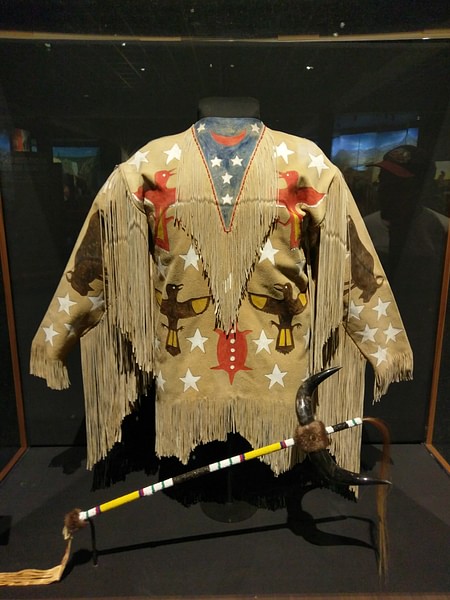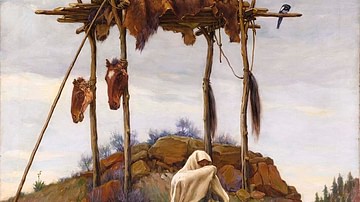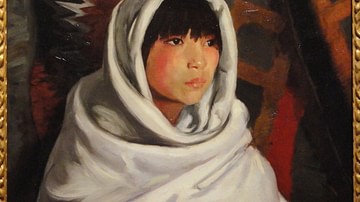The Ghost Wife is a Pawnee story dealing with loss, grief, the inability to let go of the past, and the danger of dealing with ghosts. It reflects the Pawnee understanding of the unpredictable nature of life, the certainty of death, and the fleeting nature of human happiness. It is among the most popular Pawnee tales.
In Native American belief, generally, ghosts were to be avoided, and it was always in one's best interest not to seek them out on purpose. A ghost, understood as the spirit of someone who once lived – as opposed to an eternal, elemental spirit – had passed from the changeable mortal realm to the afterlife and so knew the secrets of that world and the answers to all of the mysteries that troubled the living, such as – "why am I here?" – "what is my purpose?" – "where am I going after death?" These answers were denied to people while they lived because such knowledge would impede personal growth, and no good could come of knowing them before one was supposed to. One was, therefore, encouraged to avoid a ghost who might let such secrets slip.
Further, ghosts often missed the world they had left behind and the people they had loved and would sometimes try to lure someone to their land, drawing them on to seek their death before the time appointed for them. The Ghost Wife deals with this kind of scenario, featuring a grieving husband and the ghost of his recently deceased wife who asks him to join her.
In refusing her request, the husband brings her back into his world, believing that this will make them, as well as their child, happy forever. According to one interpretation of the story, however, there is no such thing as "forever" while one lives, and any attempt at lasting happiness is doomed to fail from the start, especially one involving interaction with a ghost. At the same time, however one interprets the events of the story, the overall theme encourages faith in the Father Above and the belief that all things happen for a reason, even if one cannot understand what that reason might be.
Although there is no date attached to The Ghost Wife, and it may have been told for centuries before Pawnee interaction with European immigrants, the faith in the spirit world, as suggested by the last line of the story, informed the Pawnee participation in the Ghost Dance in the 1890s – a movement that encouraged the revival of traditional ceremony, language, dance, and music at a time when the United States government was trying to suppress Native American culture. Some scholars attribute the survival of Pawnee culture to their participation in the ritual.






Twelve Stories of the Plains Indians
The Ghost Dance
The Ghost Dance (actually known as the Spirit Dance) was a spiritual movement initiated by the Paiute holy man Wovoka (also known as Jack Wilson, l. c. 1856-1932) in the 1890s, which encouraged participation in a kind of round dance (a traditional Native American dance ceremony) that would part the veil between worlds and bring the spirits of the dead back to fight alongside the living against the constant encroachment of white settlers on Native lands and the forced relocation of the Native peoples of North America to reservations. Scholar Adele Nozedar describes the ceremony:
The Ghost Dance was an important new religious movement that brought together many traditional practices which had been carried out for thousands of years. At its heart was a form of circle dance, but a circle dance with a difference – one that its practitioners believed was charged with power if performed correctly and repeatedly. It was said the dance could put an end to the strife and suffering of the Native Peoples. This was a dance that could restore the territory of their lost homelands, bring back the buffalo (which had been slaughtered to the point of extinction), bring about peace and, above all, resurrect the thousands of Native American men, women, and children whose lives had been lost through disease and starvation or in battles with the white men. (174-175)
Wovoka's vision of the ghosts of the dead allied with the living may seem to be at odds with the overall negative view of ghosts held by Native Americans generally – and it was – but it picked up on a long-held understanding that a ghost could be beneficial to the living if a clear agreement was made that would be respected by both parties.
Native American Ghost Stories
Native American ghost stories almost always depict ghosts as dangerous entities that are not to be trusted. There are always exceptions, however, as in tales in which one enters into some sort of agreement with a ghost that will benefit both parties in the moment or, for the living, long-term. One of the best examples of this kind of story is the Teton Sioux tale of The Man Who Wrestled with a Ghost where the young warrior, after sharing tobacco and food with a ghost in the forest, agrees to a wrestling match and, after winning, receives a prediction guaranteeing him success in defeating his enemies.
In another tale, A Teton Ghost Story, a young hunter meets the ghost of a young woman, falls in love with her, and is never heard from again. The story is open to several different interpretations but fits the paradigm of the "dangerous ghost" motif in that the hunter had not yet arrived at his time to die and yet allows himself to be taken by the ghost woman and lives in her world until he becomes a ghost himself.
These two stories come from the Plains Indians culture, just as the Pawnee tale does, but Native American nations across present-day Canada and the United States all have their own version of this kind of cautionary tale. The Mashpee of the Wampanoag Confederacy, for example, have a famous story in which a woman is visited in her home one night by the ghost of a sailor. She offers him hospitality and a warm fire, and, in return, he tells her there is a pot of gold buried behind her wigwam.
After he vanishes, the woman goes out to dig up the pot, but each time her hoe strikes the ground, she hears her two children, left sleeping inside the wigwam, cry out and rushes in to make sure they are all right. Every time she does this, she finds her children sleeping soundly. She eventually gives up and decides she will try to dig again in the morning, but when she returns to her hoe the next day, she finds only an empty hole and dirt thrown about.
The woman is not upset, however, because she concludes that the ghost of the sailor was tempting her with riches and testing her to see whether she cared more for the pot of gold than for her children. In choosing her children each time, she passed the test, and the mysterious treasure was taken away by the spirit, no doubt off to test and try to trap someone else. The story ends with the woman and her children living happily in their wigwam without the pot of gold. In this, as in many other similar tales, the ghost is not to be trusted, even though it may seem safe to do so and even if the ghost offers one some great treasure or the promise of success and happiness.
According to one interpretation of The Ghost Wife, the story takes this theme and inverts it, as it is not the spirit of the deceased that causes the problem, but the living people she engages with. The story can still be understood as a cautionary tale regarding interaction with a ghost, however, as the later events in the tale proceed from the husband convincing the spirit of his late wife to return from the land of the dead.
Text
The following text is taken from Pawnee Hero Stories and Folk-Tales by George Bird Grinnell, first published in 1893.
One time, there were living together a man and his wife. They had a young child. The woman died. The man was very sad and mourned for his wife.
One night, he took the child in his arms and went out from the village to the place where his wife was buried, and stood over the grave, and mourned for his wife. The little child was very helpless and cried all the time. The man's heart was sick with grief and loneliness. Late in the night, he fell asleep on the grave, fainting and worn out with sorrow.
After a while, he awoke and, when he looked up, there was a form standing by him. The form standing there was the one who had died. She spoke to her husband and said, "You are very unhappy here. There is a place to go where we would not be unhappy. Where I have been, nothing bad happens to anyone. Here, you never know what evil will come to you. You and the child had better come to me."
The man did not want to die. He said to her, "No – it will be better if you can come back to us. We love you. If you were with us, we would be unhappy no longer."
For a long time, they discussed this, to decide which one should go to the other. At length, the man, by his persuasions, overcame her, and the woman agreed to come back. She said to the man, "If I am to come back, you must do exactly as I tell you for four nights. For four days the curtain must remain let down before my sleeping place; it must not be raised, and no one must look behind it."
The man did as he had been told and, after four days had passed, the curtain was lifted and the woman came out from behind it. Then they all saw her, first her relations, and afterwards the whole tribe. Her husband and child were very glad, and they lived happily together.
A long time after this, the man took another wife. The first wife was always pleasant and good-natured, but the new one was bad-tempered, and, after some time, she grew jealous of the first woman and quarreled with her. At length, one day, the last-married became angry with the other and called her bad names and finally said to her, "You ought not to be here. You are nothing but a ghost anyway."
That night, when the man went to bed, he lay down, as was his custom, by the side of his first wife. During the night, he awoke, and found that his wife had disappeared. She was seen no more. The next night after this happened, the man and the child both died in their sleep. The wife had called them to her. They had gone to that place where there is always living. This convinced everybody that there is a hereafter.
Commentary
As with any Native American story, The Ghost Wife is open to various interpretations, one being the understanding mentioned above: that the living should not engage with the spirits of the dead. Scholar Larry J. Zimmerman notes, "most Native groups are agreed that the afterlife is out of the reach of the living" (249), and so, even if the spirit encountered is recognized as the ghost of someone a person once loved and trusted, the entity is actually no longer that person as they now have knowledge of what comes after death.
The husband, according to this interpretation of the story, brings about his death and that of the child by refusing to let go of his late wife and convincing her to return to the land of the living. By engaging with the spirit and encouraging her to break the rules of nature that would keep her in the land of the dead, the grieving husband violates the accepted understanding of the relationship between the two realms. Zimmerman comments:
Deaths were generally feared because, although a dead person's goodness contributed to the balance and harmony of the universe, bad qualities remained behind in the form of a ghost that could harm the living. The people most threatened by the dead were those closest to them in life. (246)
The bad-tempered second wife, although she does not seem to intend any good, articulates the prevailing wisdom of the Pawnee and other Native American nations, that the ghost wife "ought not to be here." In saying this out loud, she breaks the spell, so to speak, that has allowed the ghost wife to continue her life on earth after her appointed time of death. The second wife, then, could be seen as the heroine of the story in that she returns the world of the village to its natural course in which those who die remain dead.
The story can also be understood, however, as a commentary on the futility of believing in long-term happiness. In trying to convince the ghost of his wife to come back to him, the husband tells her, "If you were with us, we would be unhappy no longer," but after her return, the man takes a second wife, and although this was a common practice engaged in for many reasons, in this story it suggests he was not as happy after her return as he thought he would be because, as long as one lives, there is always the temptation to be dissatisfied with what one has and desire what one has not.
In this interpretation, there is no such thing as lasting happiness while one lives as that can only be realized once one has left the mortal world of constant change. The spirit of the wife tells her husband, "You are very unhappy here. There is a place to go where we would not be unhappy…Here, you never know what evil will come to you."
The uncertainty of life makes the hope of lasting happiness an impossibility and the ghost wife proves this by returning to the village with her husband, where, it can be assumed, life continued on with the same challenges and difficulties he had experienced before, later compounded by an ill-tempered second wife. The husband and child then are forced to experience the loss of the first wife all over again when she vanishes until she reunites them in the place where "nothing bad happens" after death.
Conclusion
However one interprets the story, it is informed by the Pawnee belief in the Great Mystery – the Creator God known to them as Ti-ra'wa ("Father Above"), who made all things and ordained the seasons, including a time to live and a time to die. Recognizing that Ti-ra'wa is always in control of whatever happens – even if one does not understand the meaning of an event – everything that unfolds in the story would be understood as part of a greater divine plan, which, finally, is touched on in the concluding line: "This convinced everybody that there is a hereafter."
The recognition of a "hereafter" equates with the acknowledgment of a governing force that presides over that realm as well as the world of the living, and so the story serves to highlight the cultural value of faith. Even though the husband violates the natural laws by calling his dead wife back from the spirit world, this can be turned to good by the Father Above as encouraging faith in the unseen world and recognition of the ultimate control the Great Mystery has over the lives of humans.
This same theme is apparent in the Pawnee story, Making the Sacred Bundle, in which a hunter marries a buffalo who becomes a woman and has a son with her. Through this union, the people receive the sacred bundle – the "medicine bag" of powerful spiritual items that help maintain communion between them and the Father Above. In time, the hunter becomes a great chief to his people but loses his son and then his wife before he withers away and dies. Like the husband in The Ghost Wife, Chief Eagle Feather in Making the Sacred Bundle has the free will to acknowledge and respect the laws of the creator – in this case, showing proper respect and care for one's wife – or ignore them but, either way, the Father Above is understood to finally be in control of the situation, turning even poor choices or seemingly negative circumstances to good.
This is the view held by the Pawnee in the 1890s when they adapted the Ghost Dance to their own cultural beliefs and began to observe the ceremony. Unlike the Sioux, who were persecuted by the US government for observing the Ghost Dance, the Pawnee were allowed to continue the practice up through 1914 steadily and, afterwards, sporadically. The ceremony never literally brought the dead back to life or restored the buffalo, but its practice did revitalize Pawnee culture at a critical time when it was endangered – resulting in the preservation of stories like The Ghost Wife – and so, actually, succeeded in its goal of resurrecting the dead – even if not precisely as the people had imagined.








